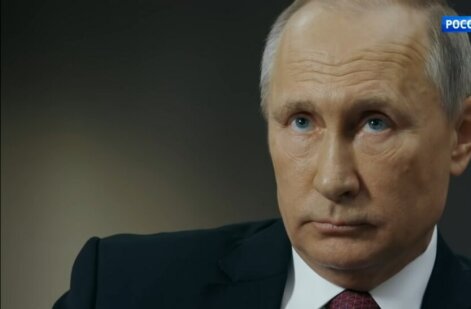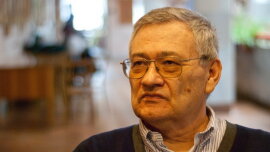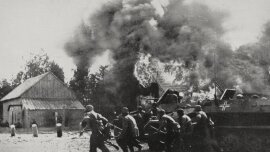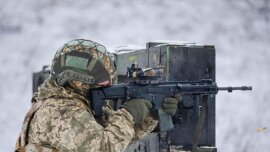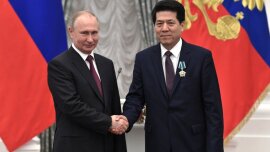Eh, Paramosha, you're a gambler!
That's your weak spot!
Mikhail Bulgakov, "Flight"
The monster's dreaming is not devoid of sense. The non-obviousness of logic in the actions of the Kremlin does not mean its absence. Another thing is that this logic may turn out to be erroneous and following it can lead to tragic consequences for everyone, including the owners of the Kremlin. The show format did not allow me to reveal the topic fully, therefore, in continuation of the conversation that began with Alexei Venediktov last Thursday, I present a brief summary of the first phase of the war and a forecast for the second phase. In connection with the abundance of materials on this topic - in the thesis form.
1. The political system of modern Russia is essentially militaristic. It is charged for war, war is the core that holds together its ideologies. The assumption of the possibility of war, the justification of war and the constant readiness for war are the main instrument of social mobilization of Russian society. Sooner or later, not in one, but in another place, the regime will end the intermediate stage of its political evolution with a big, quite traditional (with blood and cannon fodder) war. The discussion is only subject to - where and when? Judging by the external symptoms of the course of the disease - soon. But if dodge a bullet here and now, it will still hit later in another place.
2. The very formulation of the question of when the war will begin is fundamentally wrong. The war is already underway, and not the first year. We can only talk about the transition from one phase to another, including from the phase of "non-contact war" to the phase of "contact war". Why is it important? Because the transition from a state of peace to war is more complex and requires more effort than the transition from one phase of an already ongoing war to another (peace is inert, war is dynamic). And this means that the risks for Russia and everyone who is nearby, intentionally or unintentionally, to go from the stage of “cold smoking” to cooking on an “open fire” are incomparably higher than some enthusiastic young ladies who unshakably believe in the common sense of the Kremlin sages.
3. For some reason, a significant part of the inhabitants stubbornly does not take into account the fact that Russia has been in a state of global war against the United States and its allies since February 2014, that is, almost eight years. This war is being waged in several theaters of war, including the Balkans, Africa, and the Middle East. But, of course, the Ukrainian and partly Belorussian fronts are the main ones. Russia is the initiator of this war, and from the point of view of international law, it is an aggressor state, although the behavior of the United States and its allies has also been faulty, and sometimes openly provocative. Russia is waging war with modern methods, but these methods were not invented by her, she borrowed them from the West.
4. A complex of military-political measures, the purpose of which is to cause irreparable damage to the enemy, up to its complete destruction, without the active (massive) use of military force, known in the West as the "Gerasimov Doctrine" (after the head of the Russian General Staff), to put it mildly, is not an original development of Russian staff officers. Roughly speaking, this is a plagiarism of the Reagan doctrine of "star wars", twisted into the language of the native plains. Everything here is like in the old Odessa joke about the Mikhail Lermontov tanker, which turned out to be a repainted Lazar Kaganovich.
5. It is high time for Dissernet to take up the activities of the Russian General Staff. The military technologies it has been using since 2014 are a copy of the scenario implemented by the United States against the USSR in the late 70s and early 80s of the last century. The point of the strategy that was proposed to Reagan by his advisers, including the "Group B" led by the legendary Richard Pipes, was to keep the enemy at maximum tension until his vital economic and political infrastructure collapsed internally. The tools for creating the necessary level of tension were the creation of the appearance of a direct military threat (the Star Wars program), economic pressure (agreement with the Saudis on oil), psychological pressure (information media war) and support for dissidents within the country.
6. Actually, all of the above is the “color menu” that made the Kremlin shudder in the period between the first and second Ukrainian Maidans. And then the Kremlin chefs themselves learned how to cook these dishes. Today, the Kremlin has chosen Ukraine as the most convenient (that is, the most vulnerable) point for massaging Western nerves, which can cause considerable pain to the enemy. Ukraine itself is of little interest to Moscow in the military-political sense, it is only the central theater of operations in the fight against the United States. Although in the system of messianic-ideological priorities of the Kremlin, Ukraine is given a special place of honor.
7. The Kremlin's goal at this stage is to do to Ukraine what it believes the US did to the USSR forty years ago. The Kremlin initially did not want to, and now, I think, does not want to get involved in a protracted armed conflict with Ukraine. The Kremlin and, moreover, the General Staff have enough brains for this. The task is to create such a critical mass of tension around Ukraine that its internal systems would fail and Ukrainian statehood would collapse, just as it happened in the USSR. And only then - a disco: a blitzkrieg, a puppet government and the capitulation of the shocked West.
8. The voltage was created strictly according to the old American patterns. First, the military pressure, the endless "tango on tanks" along the Ukrainian borders, which is indistinguishable from the real preparations for the invasion. Secondly, economic pressure is a pirouette on gas prices. Thirdly, the support of all and every kind of internal Ukrainian conspirators. Fourthly, massive psychological processing, including in the spirit - "Russians are coming." By the way, I have serious suspicions that “the General SVR” telegram channel, which has become popular in certain circles for a while, which promises Putin’s death from terrible diseases, or the fall of Kyiv from terrible blows, is really a general of the SVR or, according to at least major. All this together was supposed to lead, according to the planners, to the complete annihilation of Ukraine, its territorial and political disintegration with a change of leadership in Kyiv without a massive use of military force.
9. Like many other plans of the Kremlin, this plan turned out to be smooth only on paper. To begin with, it was correctly understood and appreciated in London and Washington - hands, as they say, remember the trade. London quite transparently hinted that it considers the change of government in Ukraine as the main real goal of the Russian game. Washington, after some doubts, decided to take up the old ways and suggested counterplay: how to overstrain the strainer, reasonably believing that a system that could not withstand the stress once, might not withstand it the second time if it was placed in similar conditions. I believe that there are no less supporters of the “we can repeat” formula in Washington than in Moscow, just each understands the happiness in his own way.
10. Instead of persuading the Russians not to fight with Ukraine, the Americans began to literally provoke the Kremlin into an invasion, apparently hoping to get a second Afghanistan as a bonus. They invited Russia to argue with Ukraine on the topic, where the collapse will come first? The Kremlin's tactical miscalculation was that it was confident that the West would do everything to avoid an attack on Ukraine. The West reacted to such a scenario with cold detachment - not our war, your choice. Washington and its allies offered Ukraine all kinds of help, Moscow had to urgently lean on the shaky shoulder of Beijing. Time has gone.
11. At first glance, Russia's position seems very stable, and the chances of winning this strange bet are preferable. However, a closer examination of the situation raises questions. The Kremlin is being let down not so much by calculations as by emotions. Being under the influence of ideological hypnosis, it makes two interrelated mistakes - it incorrectly assesses the reasons for the collapse of the USSR and inadequately assesses the potential stability of Ukrainian statehood. In the first case, there is an overestimation of external factors, in the second - an underestimation of internal ones.
12. Judging by numerous public statements, both Putin personally and the administration led by him are convinced that the collapse of the USSR was the result of a special operation of the intelligence communities of the West and a series of tragic mistakes of the spineless Gorbachev. Without denying the significance of either one or the other, I will nevertheless note that the USSR collapsed primarily under the weight of its own insoluble contradictions of an economic, political and ideological nature, and until these contradictions matured, no pressure on the system led to collapse. The trust burst from internal tension, and pressure and mistakes, perhaps, only hastened the natural process.
13. On the contrary, following the concept of “fraternal peoples”, Putin tends to view Ukraine as an unnatural, undeniably artificial state formation, tending to spontaneous disintegration – a kind of political isotope that always strives to decompose into Russia and Poland. Therefore, the prevailing idea is that with minimal pressure, the Ukrainian regime will fall under the influence of internal centrifugal forces. In reality, the system may turn out to be much more stable than the Kremlin suggests, as it is fueled by the energy of the national liberation movement of the emerging nation. And in this case, the stronger the pressure, the higher the resistance force.
14. One way or another, but the first phase of the war ended in a fiasco. Gerasimov's doctrine did not work in full. The development of the Ukrainian revolution was blocked, but it was not possible to organize the Ukrainian counter-revolution. Accordingly, all other elements of the plan also sank, including the ultimatum to the West. But the American plan worked. Grandpa Sam froze in an inviting pose - welcome to the Ukrainian mousetrap. At that moment, it turned out that the Gerasimov doctrine had no exit strategy. Either forward or not at all, and ahead of the mousetrap. Putin's liner froze at the point of making a decision: either emergency braking, or take off to heaven.
15. The events of recent days give reason to believe that the Kremlin has made a last desperate attempt, on the verge of madness of Dostoevsky's heroes, to raise the stakes. It decided to shoot in the snowy steppes of Donbas a remake of "They Fought for the Motherland" with a multi-million extras depicting the evacuation in the winter of 1941 under the pressure of German hordes. It's hard for me to assess this from a professional cinematic point of view, but from a political point of view, after such a bet, one must either win or burn down the casino. Biden's speech leaves little chance that the West's position will change in the coming days. With that in mind, I would start moving furniture out of the Casino. Episode 1 - "The Gambler" – is over, Episode 2 is “Crime and Punishment”.
